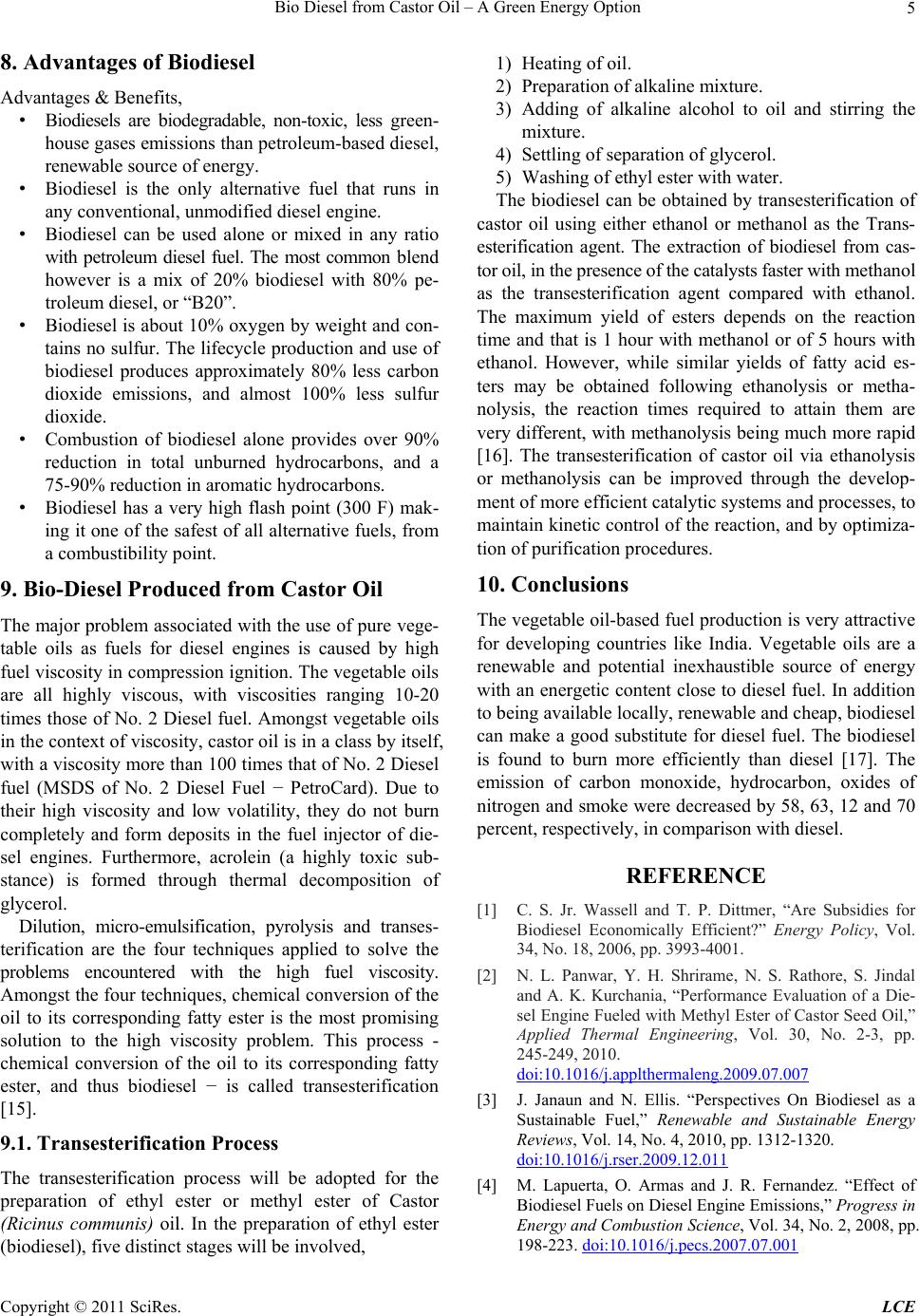
Bio Diesel from Castor Oil – A Green Energy Option5
8. Advantages of Biodiesel
Advantages & Benefits,
• Biodiesels are biodegradable, non-toxic, less green-
house gases emissions than petroleum-based diesel,
renewable source of energy.
• Biodiesel is the only alternative fuel that runs in
any conventional, unmodified diesel engine.
• Biodiesel can be used alone or mixed in any ratio
with petroleum diesel fuel. The most common blend
however is a mix of 20% biodiesel with 80% pe-
troleum diesel, or “B20”.
• Biodiesel is about 10% oxygen by weight and con-
tains no sulfur. The lifecycle production and use of
biodiesel produces approximately 80% less carbon
dioxide emissions, and almost 100% less sulfur
dioxide.
• Combustion of biodiesel alone provides over 90%
reduction in total unburned hydrocarbons, and a
75-90% reduction in aromatic hydrocarbons.
• Biodiesel has a very high flash point (300 F) mak-
ing it one of the safest of all alternative fuels, from
a combustibility point.
9. Bio-Diesel Produced from Castor Oil
The major problem associated with the use of pure vege-
table oils as fuels for diesel engines is caused by high
fuel viscosity in compression ignition. The vegetable oils
are all highly viscous, with viscosities ranging 10-20
times those of No. 2 Diesel fuel. Amongst vegetable oils
in the context of viscosity, castor oil is in a class by itself,
with a viscosity more than 100 times that of No. 2 Diesel
fuel (MSDS of No. 2 Diesel Fuel − PetroCard). Due to
their high viscosity and low volatility, they do not burn
completely and form deposits in the fuel injector of die-
sel engines. Furthermore, acrolein (a highly toxic sub-
stance) is formed through thermal decomposition of
glycerol.
Dilution, micro-emulsification, pyrolysis and transes-
terification are the four techniques applied to solve the
problems encountered with the high fuel viscosity.
Amongst the four techniques, chemical conversion of the
oil to its corresponding fatty ester is the most promising
solution to the high viscosity problem. This process -
chemical conversion of the oil to its corresponding fatty
ester, and thus biodiesel − is called transesterification
[15].
9.1. Transesterification Process
The transesterification process will be adopted for the
preparation of ethyl ester or methyl ester of Castor
(Ricinus communis) oil. In the preparation of ethyl ester
(biodiesel), five distinct stages will be involved,
1) Heating of oil.
2) Preparation of alkaline mixture.
3) Adding of alkaline alcohol to oil and stirring the
mixture.
4) Settling of separation of glycerol.
5) Washing of ethyl ester with water.
The biodiesel can be obtained by transesterification of
castor oil using either ethanol or methanol as the Trans-
esterification agent. The extraction of biodiesel from cas-
tor oil, in the presence of the catalysts faster with methanol
as the transesterification agent compared with ethanol.
The maximum yield of esters depends on the reaction
time and that is 1 hour with methanol or of 5 hours with
ethanol. However, while similar yields of fatty acid es-
ters may be obtained following ethanolysis or metha-
nolysis, the reaction times required to attain them are
very different, with methanolysis being much more rapid
[16]. The transesterification of castor oil via ethanolysis
or methanolysis can be improved through the develop-
ment of more efficient catalytic systems and processes, to
maintain kinetic control of the reaction, and by optimiza-
tion of purification procedures.
10. Conclusions
The vegetable oil-based fuel production is very attractive
for developing countries like India. Vegetable oils are a
renewable and potential inexhaustible source of energy
with an energetic content close to diesel fuel. In addition
to being available locally, renewable and cheap, biodiesel
can make a good substitute for diesel fuel. The biodiesel
is found to burn more efficiently than diesel [17]. The
emission of carbon monoxide, hydrocarbon, oxides of
nitrogen and smoke were decreased by 58, 63, 12 and 70
percent, respectively, in comparison with diesel.
REFERENCE
[1] C. S. Jr. Wassell and T. P. Dittmer, “Are Subsidies for
Biodiesel Economically Efficient?” Energy Policy, Vol.
34, No. 18, 2006, pp. 3993-4001.
[2] N. L. Panwar, Y. H. Shrirame, N. S. Rathore, S. Jindal
and A. K. Kurchania, “Performance Evaluation of a Die-
sel Engine Fueled with Methyl Ester of Castor Seed Oil,”
Applied Thermal Engineering, Vol. 30, No. 2-3, pp.
245-249, 2010.
doi:10.1016/j.applthermaleng.2009.07.007
[3] J. Janaun and N. Ellis. “Perspectives On Biodiesel as a
Sustainable Fuel,” Renewable and Sustainable Energy
Reviews, Vol. 14, No. 4, 2010, pp. 1312-1320.
doi:10.1016/j.rser.2009.12.011
[4] M. Lapuerta, O. Armas and J. R. Fernandez. “Effect of
Biodiesel Fuels on Diesel Engine Emissions,” Progress in
Energy and Combustion Science, Vol. 34, No. 2, 2008, pp.
198-223. doi:10.1016/j.pecs.2007.07.001
Copyright © 2011 SciRes. LCE